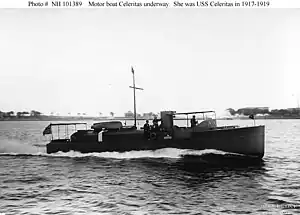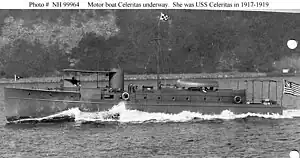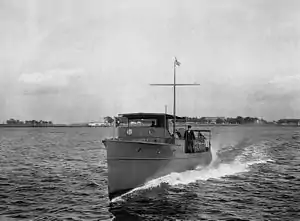 Celeritas as a private motorboat in 1916 or 1917. | |
| History | |
|---|---|
| Name | USS Celeritas |
| Namesake | Previous name retained |
| Builder | Robert Jacobs, City Island, the Bronx, New York |
| Completed | 1916 |
| Acquired | 28 May 1917 |
| Commissioned | 29 May 1917 |
| Stricken | 17 May 1919 |
| Fate | Sold 25 June 1919 |
| Notes | Operated as private motorboat Celeritas 1916–1917 |
| General characteristics | |
| Type | Patrol vessel |
| Length | 60 ft 6 in (18.44 m) |
| Beam | 11 ft 5 in (3.48 m) |
| Draft | 3 ft 3 in (0.99 m) |
| Speed | 30 miles per hour[1] |

USS Celeritas (SP-665) was a United States Navy patrol vessel in commission from 1917 to 1919.
Designed by the firm of Swasey, Raymond, & Page, Celeritas was built as a private motorboat of the same name by Robert Jacobs at City Island in the Bronx, New York, in 1916 for David Goodrich for his use in commuting. Goodrich later sold her to R. B. Myer of New York City.
On 28 May 1917, the U.S. Navy purchased Celeritas from Myer for use as a section patrol boat during World War I. She was commissioned on 29 May 1917 as USS Celeritas (SP-665).
Assigned to the 2nd Naval District in southern New England, Celeritas carried out patrol duties for the rest of World War I.
Celeritas was stricken from the Navy Directory on 17 May 1919 and sold on 25 June 1919.
Notes
- ↑ The Navy History and Heritage Command Online Library of Selected Images at http://www.history.navy.mil/photos/sh-civil/civsh-c/celertas.htm and NavSource Online at http://www.navsource.org/archives/12/170665.htm give Celeritas's speed as 30 miles per hour, implying statute miles per hour, an unusual unit of measure for the speed of a watercraft. It is possible that her speed actually was 30 knots. If 30 statute miles per hour is accurate, the equivalent in knots is 26.
References
- This article incorporates text from the public domain Dictionary of American Naval Fighting Ships. The entry can be found here.
- Department of the Navy Naval History and Heritage Command Online Library of Selected Images: Civilian Ships: Celeritas (American Motor Boat, 1916). Served as USS Celeritas (SP-665) in 1917–1919. Archived 2005-08-28 at the Wayback Machine
- NavSource Online: Section Patrol Craft Photo Archive Celeritas (SP 665)
